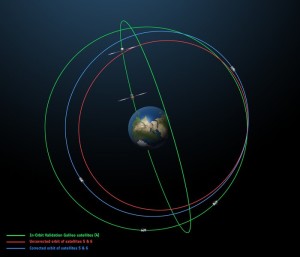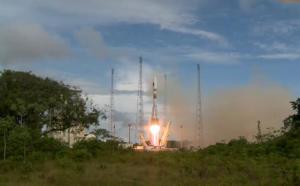On 22 August 2014, Europe’s fifth and sixth Galileo satellites were launched by a Soyuz rocket from Europe’s Spaceport in French Guiana, continuing the construction of the Galileo satnav constellation.
The problem
At first, all seemed well. Then Galileo’s Launch and Early Orbit Phase (LEOP) team at ESA’s ESOC operations centre in Darmstadt (Germany), tasked with bringing the new satellites to life, jointly manned from ESA and French space agency CNES personnel, based at ESA’s ESOC operations centre in Darmstadt, raised the alarm. Unusually low power and instability in the radio signals they were receiving from the pair of satellites showed they were not where they should have been because of a malfunction of the Soyuz Fregat launch vehicle.
An Independent Enquiry Commission of Arianespace, European Commission and ESA experts was set up immediately to work closely with Russia’s Roscosmos space agency. The cause of the Fregat upper stage anomaly was eventually
pinned down to a single bracket of aluminium, used to hold the propellant and helium lines in place. The cold liquid helium froze the nearby propellant line, blocking the use of Fregat’s attitude control thrusters. Revised installation procedures now prevent recurrence of the problem.
The satellites were left in an elliptical orbit that saw them travelling as high as 25 900 km above Earth and down to a low point of 13 713 km, with the orbit wrongly inclined with respect to the equator.
The first priority was to ensure the satellites were safe and stable. Within four hours the team determined the actual orbit, then generated new commands to repoint the ground antennas and establish robust radio links. Over the following few days, with assistance from ESA’s Galileo project and satellite manufacturer OHB, the LEOP team developed procedures to release the trapped solar wings, boosting the available power to a safe margin as they pointed towards the Sun.
Both satellites were left in a mode pointing to the Sun but they could not be used for navigation purpose nor be tested.
The solution
Different scenarios were prepared by ESA supported by experts from industry and national space agencies and proposed to the European Commission which decided to recover both satellites.
The two satellites were secure in the near term, their control transferred to the Galileo Control Centre in Oberpfaffenhofen, Germany, overseen by the Spaceopal company. But their incorrect orbits meant their navigation payloads could not be switched on for testing. The Earth sensors used to point their navigation antennas stopped working around perigee (their lowest point) because Earth’s disc filled their field of view. In addition, the lower orbits were exposing them to heightened levels of harmful radiation.
Limited fuel meant the satellites’ originally assigned destination was out of reach, but their orbits could still be modified to make them suitable for navigation purposes. A recovery plan was devised between ESA’s Galileo team, ESOC flight dynamics specialists, along with personnel from SpaceOpal, OHB with the support of the French (CNES), Italian (ASI), German (DLR) and British (UKSA) space agencies experts. The scheme involved a multiple series of manoeuvres, gradually raising the lowest point of the satellites’ orbits more than 3500 km while making them more circular.

The original (in red) and corrected (in blue) orbits of the fifth and sixth Galileo satellites, along with that of the first four satellites (green)
The fifth Galileo entered its corrected orbit at the end of November 2014, while the sixth satellite followed it during March 2015. Their positions now mirror each other, meaning they overfly the same location on the ground every 20 days. This compares with a standard Galileo repeat pattern of 10 days, helping to synchronise their ground tracks with the rest of the constellation. Testing of both their navigation and search and rescue payloads followed swiftly.
Testing of the fifth satellite began in December 2014, with the other following in spring 2015. These tests confirmed the quality of the new-generation satellites. The fifth satellite has even been combined with its Galileo predecessors to contribute to position fixes with an excellent level of performance comparable to that expected
in the normal orbit.
The main hurdle in using them operationally is that their orbits fall outside of the ‘almanacs’ broadcast within navigation messages to locate satellites. However, at the raised altitude, the satellite’s signal can still be received in open sky search. Full integration of those satellites in the operational constellation is still under analysis, in particular for what concerns the generation of the navigation message by the operational ground segment. Final decision on the operational use of these satellites will be taken on the basis of a thorough cost-benefit analysis.

